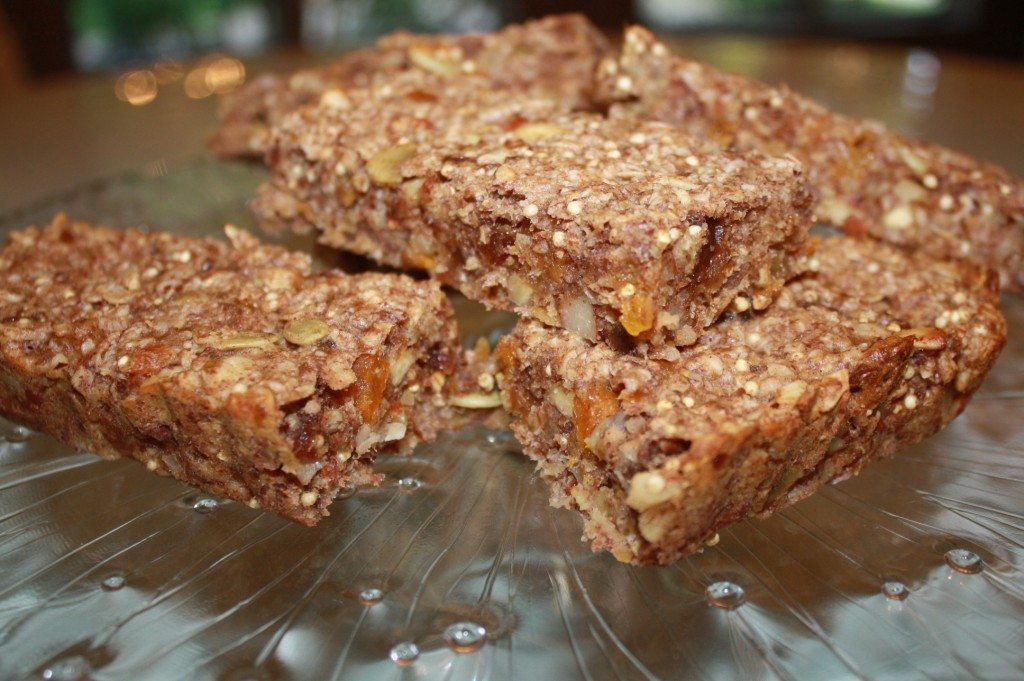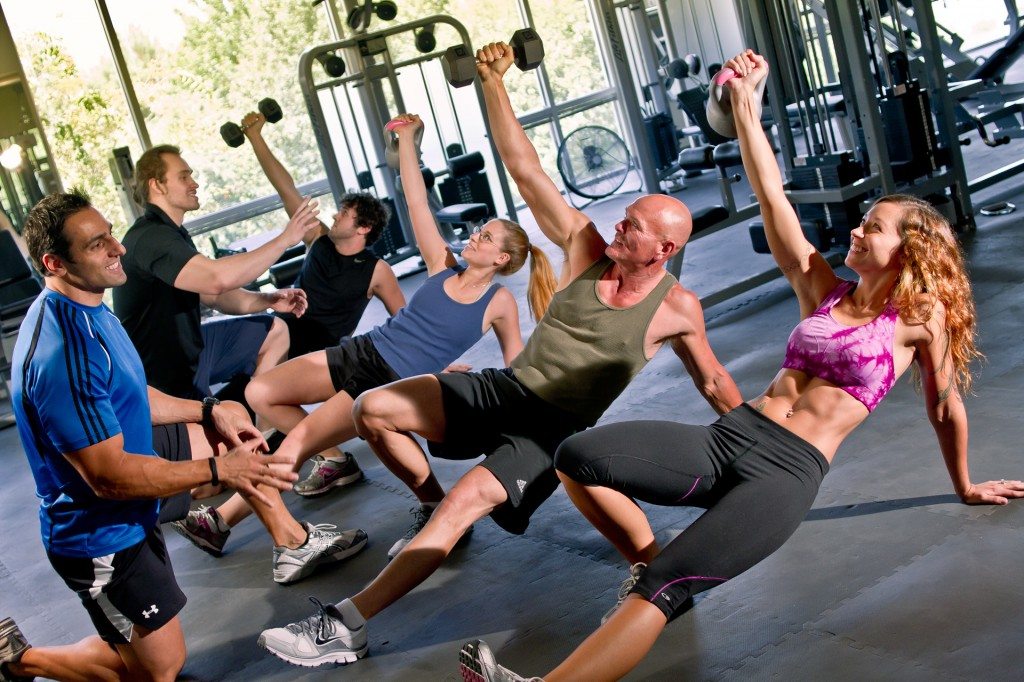


Apricot Granola Bars
Homemade Granola Bars For The Kids (Or You!)
Apricot Granola Bars
The ultimate satisfaction is when I make something nutritious for my kids and they gobble it up and ask for more. I knew this would be a winner just by looking at the recipe; my kids were standing in front of the oven waiting for these babies to come out. I got the original recipe from Vanilla & Spice. I didn’t change much either, just the type of fruit I used , type of salt, and type of sweetener. These bars are chewy, crunchy, and sweet. Oh and they make the house smell divine!
Ingredients:
1/2 c. raw almonds
1/4 c. dates, chopped
1/4 c. dried apricots (make sure there’s no sugar or sulfur added)
1 c. quick oats
2 tbsp. dry millet
1/4 c. mixed seeds (half pumpkin and half sunflower-unsalted)
1 tsp. cinnamon
1/4 tsp. pink himalayan salt
2 tbsp. ground flax seed
1/2 c. almond butter
2 ripe bananas, mashed
1 tsp. vanilla extract
1 tbsp. honey (optional)*
Preparation:
Preheat oven to 350. Prepare an 8 x 8 pan by lining with parchment paper. Place almonds, dates, and apricots in a food processor until roughly chopped). Transfer to a bowl and add oats, millet, seeds, cinnamon, salt, and flax. Use a whisk to mix thoroughly. Place almond butter and mashed bananas together in a small bowl and microwave for 30 seconds. Stir. Microwave for 15 more seconds. Stir until smooth. Stir in the vanilla and honey. Pour wet mixture into the dry ingredients and stir with a rubber spatula until evenly coated. Pour mixture into prepared pan and press down firmly with spatula. Bake for 22-27 minutes, until edges are brown and top is firm to the touch. Cool completely, then slice into 8 bars.
*If I was making these for myself, I would leave the honey out to make them less sweet. Macros below include the recipe WITH the honey.
Macros per bar: 285k cals, 15.9g fat (1.1g sat, 3.2g poly, 6.1g mono), 31.7g carbs (6.9g fiber, 12.5g sugar), 8.3g protein, 62.2mg sodium, 205.2mg potassium
References:
Vanilla & Spice – Healthy Treats and Vegetarian Eats
Fadi Malouf – Nutritionist and Personal Trainer

Blueberry Mango Smoothie
Drink Your Fruits and Veggies
Blueberry Mango Smoothie
I can’t believe I let the whole summer go by without posting a smoothie recipe. What was I thinking?! Well, better late than never. This one is worth the wait. There’s lots of fruit and veggies in this drink; along with healthy fats, anti-inflammatory and detox properties, and an energy boost. It’s so refreshing too. I’ve had one three days in a row and honestly, its been the highlight of my day. You might say I need to get a life if this drink is the highlight of my day or you may just need to try it yourself and see if it doesn’t have the same effect on you. For real, do it. Now.
Ingredients:
1 c. unsweetened almond milk
1 c. kale, chopped and packed
2 c. spinach, packed
2 leaves romaine lettuce, chopped
1/2 lemon, peeled
1.5 c frozen blueberries
1 c. frozen mango chunks
15 g raw ginger
1/4 avocado
Preparation:
Using your food processor or blender (I have a Ninja), begin by adding the almond milk and the greens. Blend until liquid. Continue adding ingredients and blending along the way until you’ve added everything. Be sure not to overheat your machine; stop every little bit to give your machine a break and to scrape the sides. This makes two servings and looks even more appetizing in an adorable mason jar. Drink one immediately and share the other with a friend. Or do like I do, and save it for later by stashing it in the back of the refrigerator where nobody else will find it.
Macros per one out of two servings: 170k cals, 6.2g fat (.7g sat, .6g poly, 2.1g mono), 33.5g carbs (8.9g fiber, 19.2g sugar), 4.4g protein, 132.1mg sodium, 659.8mg potassium
References:
Fadi Malouf – Nutritionist and Personal Trainer

Exercise Less To Be More Fit
Exercise Less To Be More Fit
Sounds too good to be true, right? A recent study showed that the amount of exercise is what matters not the frequency. The study involved over 2,000 participants who were asked to wear accelerometers to track their physical activity. The findings indicated participants who exercised for a total of 150 minutes over a day or two versus participants who spread their 150 minutes out over a week’s time received the same health benefits of the workouts.
This is good food for thought. New “evidence” is constantly surfacing about the latest in health and nutrition. Its hard to know whats accurate. Six out of seven days of the week, you’ll find me up at 5:30 am getting ready for my workouts which last 45-60 minutes. How is it even possible to cram that much exercise into a day or two? And even if it was possible, it doesn’t seem realistic it would produce the same health benefits. Surely, I would collapse from exhaustion before I was even halfway through; that doesn’t sound very healthy. I may not ever find out the answer to that, but I have a couple guesses. When reading studies like these, you’ve got to take into consideration what isn’t being said as much as what is being said. For instance, the author defines “health benefits” as a decrease in risk factors such as diabetes, stroke, and heart disease. A health benefit to me is those things plus a leaner body with less fat and more muscle. However, the study doesn’t mention taking it to that level. In that case, a participant who didn’t exercise at all and then started exercising 150 a minutes a week within the time frame of a couple of days, of course, would receive those health benefits.
Common sense is our friend. I love staying up to date on current health and nutrition news, but I take it all with a grain of pink himalayan salt. I have to consider the source, the context, and most importantly, what works for me. Working out six days a week works for me. I’m a nicer person when I work out, I feel more prepared for chasing around two small children, and I like having that time at the beginning of the day all to myself while the rest of the world sleeps peacefully. All in all, I don’t think I’ll be testing out this theory anytime soon. What about you?
References:
Fadi Malouf – Nutritionist and Personal Trainer

Mediterranean Chickpea Salad
Low-Calorie And Quick Salad
Mediterranean Chickpea Salad
Have you noticed a theme yet? If its quick and easy and if it can be turned into a salad, I’m all over it. Another salad creation here that’s perfect for summertime. And this is probably the easiest one yet, because some of the ingredients (dare I say it?) are canned. I don’t normally use canned ingredients, but sometimes you’re just in a hurry and its better than nothing (also better than falling prey to a fast food place). I just look for the no sodium/low sodium version of whatever it is I need. A lot of canned items have a ton of added salt. Why let someone else determine how you season your food? If its beans, I rinse really well before using. Enough about that, though, here’s your dinner for tonight and get ready for lots of pictures.
Ingredients:
1 medium tomato, chopped
5 mini cucumbers (or 1 regular), sliced
1 red bell pepper, seeded and chopped
1 medium avocado, chopped
1/2 of a small red onion, diced
1 container of low sodium albacore tuna
1 can of garbanzo beans, rinsed and drained
1 tsp. evoo
1 tsp. balsamic vinegar
dash of black pepper
1/4 c. fresh cilantro, chopped
Preparation:
In a bowl, mix together tomatoes, cucumber, red bell pepper, avocado, and red onion.
Add the tuna and garbanzo beans. Stir to combine. Then drizzle with evoo and balsamic vinegar. Add pepper and toss to coat.
Finally, top with cilantro and you’re done! Enjoy!
Macros per one out of four servings: 233k cals, 9.3g fat (1.1g sat, .9g poly, 5g mono), 29.9g carbs (9.4g fiber, 5.5g sugar), 16g protein, 12.5mg cholesterol, 357.4mg sodium, 478.3mg potassium
References:
Tania Funduk – Food and Fitness Guru
Fadi Malouf – Nutritionist and Personal Trainer









